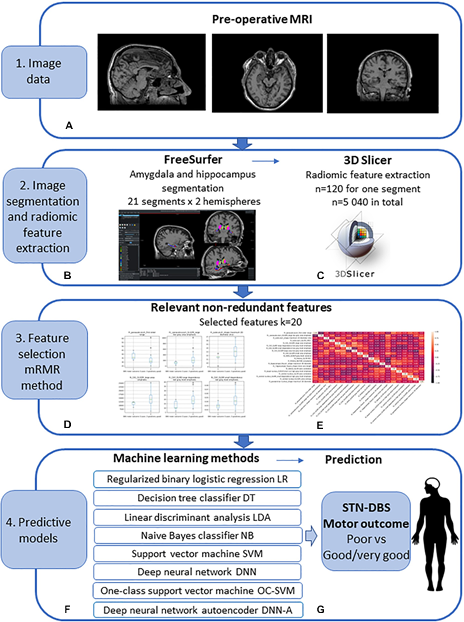Category: Parkinson's Disease: Pathophysiology
Objective: To estimate STN by IPGs induced with DBS effects for Parkinson’s by ‘radiomic-features(RF)’/symptoms-manifestations attained as of pre-opMRI, study possibility of ‘RF’ of amygdala-nucleus’ plus hippocampal sub-fields for estimating Parkinson`s ‘STN-DBS’ motoric consequences. Preferred features employed in machine-learning(ML) algorithmic-techniques offer greater estimation-precision, ‘sensitivity/specificity’ plus area-under-curve(AUC) of receiver-operating-characteristic(ROC) curve of ML-prototype-models were projected also averaged circa thousand boot strapped repeats.
Background: Parkinson p/t`s with an idiopathic disease course and responders to levodopa (L-Dopa) therapy are even treated as best candidates for DBS. Yet, ‘clinical-effect’ of this minimally-invasion differs amongst Parkinson p/t`s, also improved p/t ‘choice-criteria’ else “objective-markers” are necessary. For building novel-biomarkers based-on data-driven inference of radiologic-images, Radiomics (high throughput extraction of quantitative imaging features or texture (radiomics) from imaging) are best in field of Parkinson and cancer research.
Method: 36Parkinson`s underwent DBS surgery. 5indicated DBS motoric-results bad(15%). 9 ‘amygdala-nucleus’, 12 hippocampal sub fields were parted. Also, ‘Py-Radiomics’ system employed to infer more features for all nucleus and sub field following in thousands-of-features(5040). The minimum-redundancy and maximum relevance (MR-MR) technique is applied to cut to 20, 8 ML-techniques: normalized ‘binary logistic regression’ (‘LR’), decision-tree-classifier(‘DT’), linear-discriminant-analysis(‘LDA’), naïve-Bayes-classifier(‘NB’), support-vector-machine(SVM) kernel, feed-forward neural-network(DNN) deep, one-class(OC)SVM, feed-forward NW-based (neural) auto-encoder to discover glitch (DNN-A)etc. used to create prototype-models meant for bad v/s nice, great “STN-DBS” motoric-effect projection.(Fig1- System-data-flow diagram of pre op estimation of STN neurons e DBS designed for Parkinson p/t`s.
Results:
The maximum normal likelihood precision is achieved by standardized (96.65±7.24%,AUC0.98±0.06) regression plus 87.25±14.80% and AUC 0.87±0.18 by DNN.
Conclusion:
Findings yields the possible ability of RF-features obtained as of hippocampal plus amygdala-nuclei 7T MRI within likely-estimation of “STN-DBS” motoric-results meant for Parkinson p/t`s.
To cite this abstract in AMA style:
V. Rama Raju. Analysis of subthalamic-nuclei deep brain stimulation using radiomic feature-manifestations: a quantitative approach [abstract]. Mov Disord. 2023; 38 (suppl 1). https://www.mdsabstracts.org/abstract/analysis-of-subthalamic-nuclei-deep-brain-stimulation-using-radiomic-feature-manifestations-a-quantitative-approach/. Accessed December 30, 2025.« Back to 2023 International Congress
MDS Abstracts - https://www.mdsabstracts.org/abstract/analysis-of-subthalamic-nuclei-deep-brain-stimulation-using-radiomic-feature-manifestations-a-quantitative-approach/

